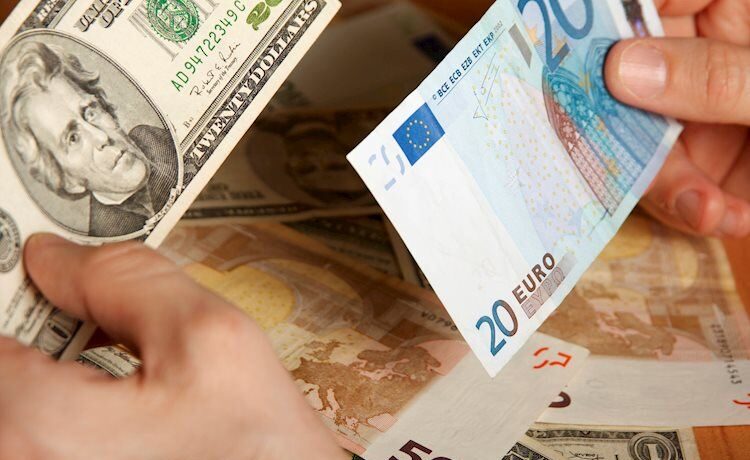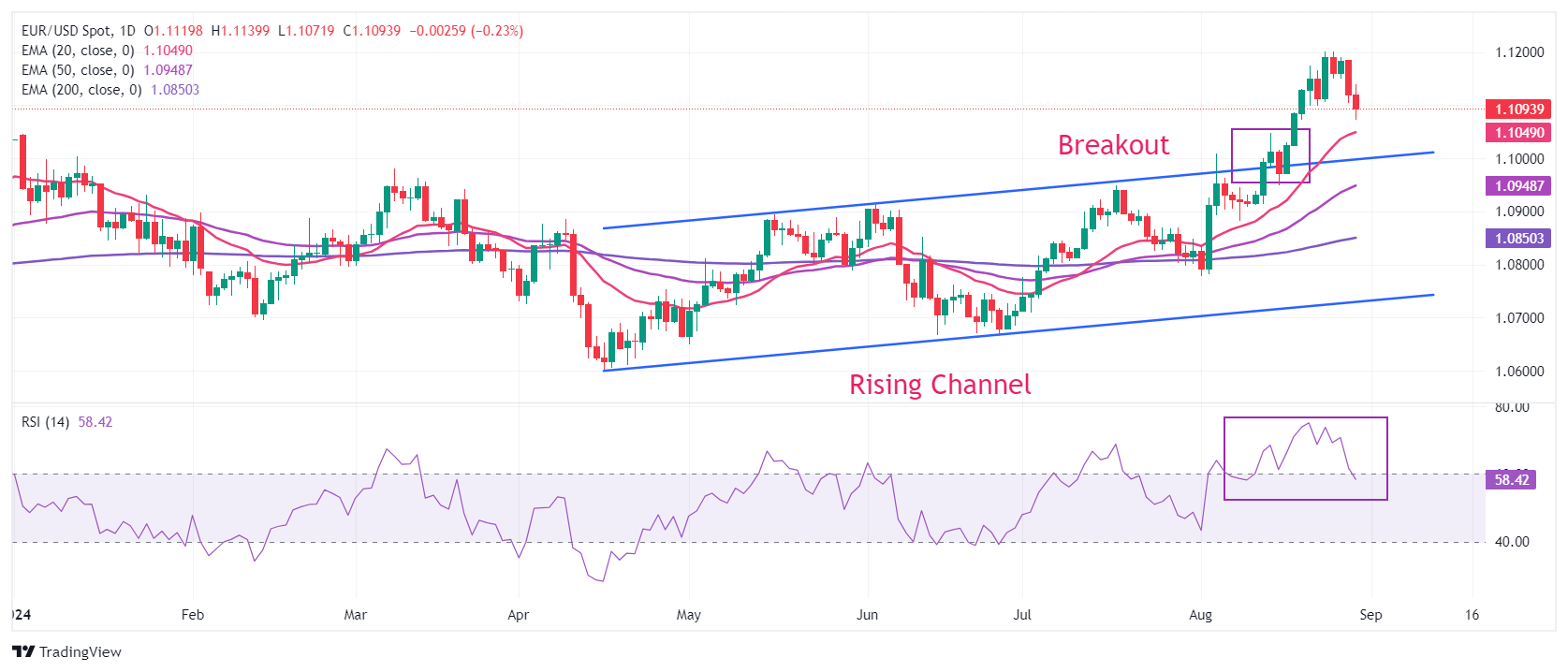- EUR/USD dives below 1.1100 as lower inflation in Spain and in six key German states prompts expectations of another ECB rate cut.
- Eurozone and German inflation are estimated to have slowed further in August.
- The US core PCE inflation data could influence market expectations for Fed rate-cut size in September.
EUR/USD extends its downside below the crucial support of 1.1100 in European trading hours. The shared currency pair weakens on the Euro’s (EUR) underperformance against its major peers as traders seem to be certain that the European Central Bank (ECB) will cut interest rates in September.
A sharp slowdown in price pressures in Spain and six important German states has boosted ECB September rate cut bets. The Annual Harmonized Index of Consumer Prices (HICP) in Spain came in at 2.4%, the slowest in year-to-date (YTD).
Firm speculation for ECB September rate cuts was already prompted by consistently easing Eurozone price pressures and its poor economic outlook, as suggested by the flash HCOB PMI report for August. However, the Eurozone Economic Sentiment Indicator, Industry Confidence, and Services Sentiment have come in better than expected in August. On the contrary, Consumer Confidence deteriorated to -13.5 from the estimates and the former release of -13.4.
The ECB is also expected to deliver an additional rate cut somewhere in the last quarter of the year. A few ECB policymakers appear to be comfortable with the central bank reducing its key borrowing rates further this year.
Dutch policymaker Klaas Knot said to a conference panel on Tuesday that “as long as our disinflation path still converges to a return to 2% inflation at or before the end of 2025, then I’m comfortable with gradually taking our foot off the brake.” When asked about September rate cut expectations, Knot said: “I will have to wait until I have the full data and information set going into that meeting to decide my position on whether September is appropriate,” adding that “I would have to do so again in October, December and whenever,” reported Reuters.
The German and Eurozone flash HICP data for August will be published at 12:00 GMT later today and on Friday, respectively. German annual HICP is estimated to have grown at a slower pace of 2.3% from 2.6% in July. Month-over-month, the HICP is forecasted to have remained flat after rising 0.5% in July.
Euro PRICE Today
The table below shows the percentage change of Euro (EUR) against listed major currencies today. Euro was the strongest against the Swiss Franc.
| USD | EUR | GBP | JPY | CAD | AUD | NZD | CHF | |
|---|---|---|---|---|---|---|---|---|
| USD | 0.21% | -0.00% | -0.04% | -0.20% | -0.52% | -0.56% | 0.13% | |
| EUR | -0.21% | -0.23% | -0.26% | -0.43% | -0.73% | -0.78% | -0.11% | |
| GBP | 0.00% | 0.23% | -0.06% | -0.20% | -0.50% | -0.54% | 0.16% | |
| JPY | 0.04% | 0.26% | 0.06% | -0.14% | -0.47% | -0.53% | 0.19% | |
| CAD | 0.20% | 0.43% | 0.20% | 0.14% | -0.31% | -0.35% | 0.35% | |
| AUD | 0.52% | 0.73% | 0.50% | 0.47% | 0.31% | -0.03% | 0.68% | |
| NZD | 0.56% | 0.78% | 0.54% | 0.53% | 0.35% | 0.03% | 0.70% | |
| CHF | -0.13% | 0.11% | -0.16% | -0.19% | -0.35% | -0.68% | -0.70% |
The heat map shows percentage changes of major currencies against each other. The base currency is picked from the left column, while the quote currency is picked from the top row. For example, if you pick the Euro from the left column and move along the horizontal line to the US Dollar, the percentage change displayed in the box will represent EUR (base)/USD (quote).
Daily digest market movers: EUR/USD dives on Euro’s weakness
- EUR/USD faces a sharp sell-off, sliding below the round-level support of 1.1100 in Thursday’s European session. The major currency pair extends its correction after some preliminary inflation data from Spain and six important German states showed that price pressures continued to abate in August, increasing bets of an upcoming interest-rate cut by the European Central Bank (ECB). Meanwhile, the US Dollar increased further above Wednesday’s high, with the US Dollar Index (DXY) – which tracks the Greenback’s value against six major currencies – rising to near 101.30.
- The sharp recovery in the US Dollar suggests that investors are turning risk-averse with United States (US) Personal Consumption Expenditure Price Index (PCE) data for July on the horizon. The underlying inflation data is expected to influence market speculation for the likely size of Federal Reserve (Fed) interest-rate cuts in September.
-
The PCE inflation report is expected to show that the annual core inflation rose by 2.7% in July, faster than the 2.6% seen in June. Month-over-month, core PCE is estimated to have grown steadily by 0.2%.
-
In Thursday’s session, investors will keenly focus on the revised estimates of Q2 Gross Domestic Product (GDP) and the Initial Jobless Claims data for the week ending August 23 at 12:30 GMT. Q2 GDP revised estimated are unlikely to impact the US Dollar unless there comes a substantial change. In Europe, the preliminary August inflation data for overall Germany will be published at 12:00 GMT.
-
Investors will also focus on the Jobless Claims data as the Fed is now vigilant to downside risks to the labor market.. Fed Chair Jerome Powell vowed to support deteriorating labor market strength in his speech at the Jackson Hole (JH) Symposium.
Technical Analysis: EUR/USD corrects further below 1.1100
EUR/USD falls sharply below 1.1100 after failing to extend its upside above the crucial resistance of 1.1200. The near-term outlook of the major currency pair is still firm as all short-to-long-term Exponential Moving Averages (EMAs) are sloping higher.
Earlier, the major currency pair strengthened after breaking above the Rising Channel formation on a daily timeframe.
The 14-day Relative Strength Index (RSI) has declined below 60.00 after turning overbought near 75.00.
On the upside, the recent high of 1.1200 and the July 2023 high at 1.1275 will be the next stop for the Euro bulls. The downside is expected to remain cushioned near the psychological support of 1.1000.
(The story was corrected at 10:25 GMT to say in the first paragraph that ” EUR/USD faces a sharp sell-off, sliding below the round-level support of 1.1100 in Thursday’s European session not 1.100)

















